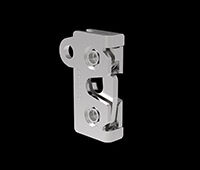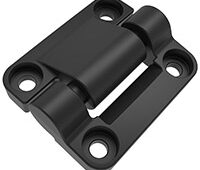By Jonathan Higgins, Field Applications Engineer, Spirol International Corp., Danielson, Conn.
A manufacturer switched from slotted pins to coiled pins for a new coupler design that saves part and labor costs, improves safety, and reduces warranty claims.
A coupler manufacturer was asked to design a stop feature that could withstand high impact loads for construction equipment. The coupler requires a positive stroke of the hydraulic lever each time one attachment is released. The manufacturer used a slotted pin as the stop mechanism. Because the slotted pin cannot easily conform to the hole size, it folds and creates a limited interference fit at three points to the hole. This causes stress to concentrate 180° from the slot. Over time, this weak area was exacerbated by impact loads, leading to failure. The slotted pin was at risk to fall out of the hole and the productivity and safety of the construction site was compromised.

A coupler manufacturer used a slotted pin as a stop mechanism.
To correct the problem, the manufacturer inserted a second slotted pin into the first, called composite pinning. While it is a stronger, more rigid pin, problems normally arise with this design. In order to function, the gaps of each slotted pin must orient 180° to each other. The seam of the inner slotted pin must butt to the seam of the outer pin first. If the outer pin butts first, the inner pin provides no additional strength. Even when the correct design is selected, composite pins are labor intensive and prone to human error during assembly. The higher rigidity of the composite pin can also cause the hole damage, just as a solid pin would. Initially, in this application, the composite pin could withstand more cycles. However, over time, the same cracking problem appeared. Stress concentrations that were inherent to the slotted pin’s design continued to cause failure opposite to the seam. The more expensive and cumbersome design was only a short term solution.

Quick couplers increase an excavator’s versatility by allowing attachments for digging, grading, and compacting to be changed in minutes. The reliability and performance of couplers is critical to the productivity at a construction site. If a coupler fails to work properly, the resulting downtime is costly.
Coiled pin to the rescue

Spring pins can flex into a hole that is smaller than the pin’s original outside diameter.
The coupler manufacturer solicited Spirol’s application engineering team to review the coupler design and the manufacturer’s performance objectives. A heavy duty coiled pin was recommended for the pin’s unique combination of strength and flexibility. The heavy duty coiled pin is progressively rolled with thinner gauge strip. Yet the additional cross-sectional material has greater strength than the slotted pin. This creates a strong pin with increased flexibility, so the pin can withstand impact loads and stay connected. The coiled pin improved safety, and reduced the cost of piece parts, labor, and warranty claims.

Coiled pins
A spring pin can flex into a hole that is smaller than the pin’s original (pre-installed) outside diameter. A spring pin’s ability to return to its original shape after installation makes it self retaining. Retention is established by friction between the pin and host wall and not by deformation as with alternative solid press fit pins. This concept of preserving joining components (pin and host) during installation increases the life of dynamic assemblies.

A coupler manufacturer designed a stop feature that could withstand high impact loads.

A rendering of the Spirol coiled pin design. No orientation of the coiled pin is required.

Composite slotted pins are oriented 180° from each other.
A spring pin can be described as a coiled and slotted pin. Both, however, have distinct differences between the two types of pins. Here are a few examples:
As a slotted pin is installed, the pin’s spring-like characteristic is reduced to a narrow seam opposite the slot. The pin’s limited flexibility forms stress concentrations. This portion of the slotted pin is susceptible to failure if the pin is subject to impact loads.
A second scenario for slotted pin failure is caused by the slotted pin’s rigidity after installation. When a slotted pin is installed, the slot closes and the pin can act like a rigid hollow tube. This tube behaves similarly to a solid pin. As a solid member, impact loads are transmitted to the host wall, causing hole elongation. As the hole size increases, impact loads intensify, then the pin cracks, falls out of the hole, or both.
One way to avoid these problems is to use a coiled pin. As it is installed, stress is distributed throughout the fastener instead of being concentrated along a line. The coiled pin’s design also ensures flexibility after installation. For the life of the assembly, the coiled pin can absorb impact loads without damaging the host of the pin. Unlike the slotted pin, it remains an active member of the joint, continuously absorbing loads.
Discuss this on the Engineering Exchange:
Spirol International Corporation
www.spirol.com
::Design World::
Filed Under: FASTENING • JOINING • locks • latches • pins





Tell Us What You Think!